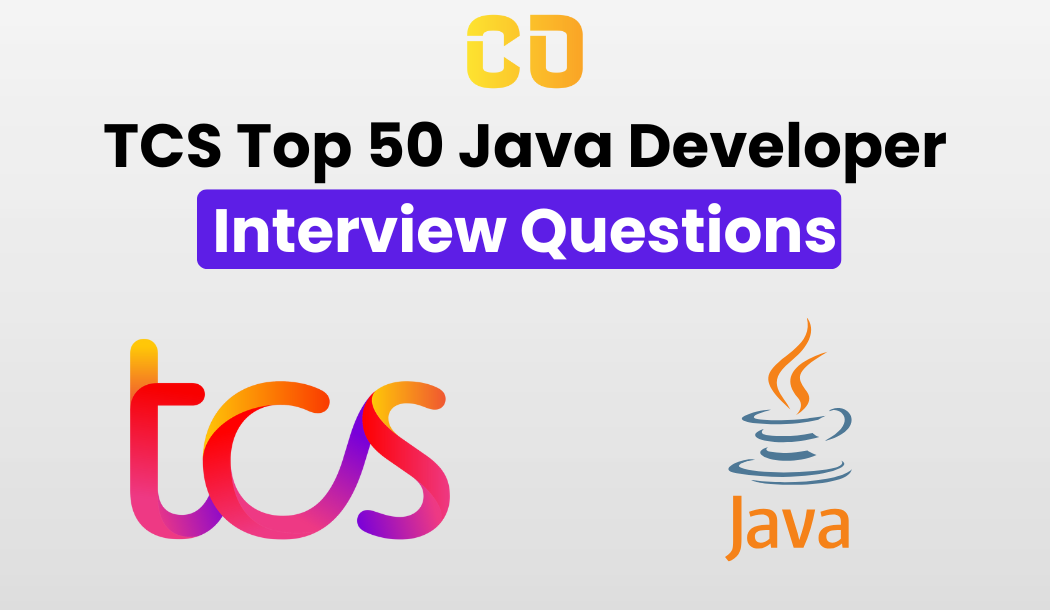A comprehensive guide featuring the top 50 interview questions for Java developers, designed to help you prepare for your next job interview.
Core Java
1. What is the difference between Java and C++?
Java:
- Platform Independence: Java is designed to be platform-independent at both the source and binary levels, using the Java Virtual Machine (JVM) to run compiled code.
- Memory Management: Java has automatic garbage collection, which helps in memory management by automatically reclaiming memory used by objects that are no longer referenced.
- Syntax: Java's syntax is simpler and more streamlined compared to C++, focusing on ease of use.
- Multithreading: Java has built-in support for multithreading, which allows concurrent execution of two or more threads.
- Object-Oriented: Everything in Java is an object (except for primitive types), which enforces an object-oriented programming approach.
C++:
- Platform Dependent: C++ is generally platform-dependent; code must be compiled on each platform.
- Memory Management: C++ requires manual memory management using pointers and dynamic allocation (e.g.,
newanddelete), which can lead to memory leaks if not handled properly. - Syntax Complexity: C++ has a more complex syntax with features like multiple inheritance and operator overloading.
- Performance: C++ often performs better than Java in terms of execution speed, especially in system-level programming.
- Object and Procedural Programming: C++ supports both object-oriented and procedural programming paradigms.
2. Explain the concept of encapsulation in Java.
-
Encapsulation is one of the four fundamental Object-Oriented Programming (OOP) principles. It involves bundling the data (variables) and methods (functions) that operate on the data into a single unit known as a class. It restricts direct access to some of an object’s components, which can prevent the accidental modification of data.
Key Features of Encapsulation:
- Access Modifiers: Java uses access modifiers (
private,protected,public, and package-private) to control access to class members.privatemembers cannot be accessed from outside the class.publicmembers can be accessed from any other class.protectedmembers can be accessed in subclasses and classes in the same package.
- Getters and Setters: Encapsulation is typically implemented through getter and setter methods, which provide controlled access to the private variables.
3. What is inheritance in Java? Give an example.
-
Inheritance is a mechanism in Java that allows one class (child class or subclass) to inherit the fields and methods of another class (parent class or superclass). It promotes code reusability and establishes a relationship between classes.
Key Types of Inheritance:
- Single Inheritance: One class inherits from another.
- Multilevel Inheritance: A class inherits from another derived class.
- Hierarchical Inheritance: Multiple classes inherit from a single parent class.
- Multiple Inheritance: Java does not support multiple inheritance with classes to avoid ambiguity, but it can be achieved using interfaces.
4. How does Java handle memory management?
-
Java handles memory management through a combination of stack and heap memory, with automatic garbage collection.
Key Points:
- Stack Memory: Stores method calls and local variables. Memory is allocated when a method is invoked and deallocated when the method exits.
- Heap Memory: Used for dynamic memory allocation. All objects created with the
newkeyword are stored in the heap. - Garbage Collection: Java has a built-in garbage collector that automatically frees up memory by removing objects that are no longer referenced. This reduces the risk of memory leaks but does not guarantee immediate memory release.
5. What is the difference between "==" and ".equals()" in Java?
-
"==": This operator checks for reference equality. It compares whether two references point to the same object in memory.
-
".equals()": This method checks for value equality. It compares the content of two objects to determine if they are logically equivalent. The default implementation of
.equals()in theObjectclass checks for reference equality, but it can be overridden in a subclass to check for value equality.
6. Can you explain the concept of polymorphism in Java?
-
Polymorphism is another fundamental OOP principle that allows one interface to be used for a general class of actions. The specific action is determined at runtime based on the object type. There are two types of polymorphism in Java:
-
Compile-Time Polymorphism (Method Overloading): This occurs when multiple methods in the same class have the same name but different parameter lists (different types or numbers of parameters).
-
Runtime Polymorphism (Method Overriding): This occurs when a subclass provides a specific implementation of a method that is already defined in its superclass. The method to be invoked is determined at runtime based on the object’s type.
7. What is the use of "this" keyword in Java?
-
The
thiskeyword in Java is a reference variable that refers to the current object. It is used in several contexts:- To differentiate between class attributes and parameters with the same name.
- To call one constructor from another within the same class (constructor chaining).
- To pass the current object as a parameter to methods or constructors.
8. How does Java handle exceptions?
-
Java handles exceptions through a robust mechanism that involves using the
try,catch,finally, andthrowkeywords. This mechanism allows developers to gracefully manage errors that occur during program execution.Key Concepts:
- try block: Contains code that might throw an exception.
- catch block: Catches and handles the exception if one is thrown in the associated try block.
- finally block: A block that executes after the try and catch blocks, regardless of whether an exception was thrown or caught. It’s often used for cleanup code, like closing file streams.
- throw statement: Used to explicitly throw an exception.
- throws clause: Declares that a method can throw exceptions of a specified type.
9. What is the difference between throw and throws in Java?
-
throw:
- The
throwkeyword is used to explicitly throw an exception from a method or any block of code. - When
throwis used, it creates an exception object and hands it over to the JVM (Java Virtual Machine), which looks for appropriate exception handling. - You can throw either a checked or unchecked exception.
- The
-
throws:
- The
throwskeyword is used in a method signature to declare exceptions that can be thrown by the method. - It informs the caller of the method about the exceptions that may occur.
- You can declare multiple exceptions separated by a comma.
Example:
- The
10. Can you explain the concept of abstraction in Java?
-
Abstraction is a key principle of Object-Oriented Programming (OOP) that focuses on hiding the internal implementation details of a class and exposing only essential features or functionalities.
There are two main ways to achieve abstraction in Java:
-
Abstract Classes: An abstract class cannot be instantiated, and it can have both abstract (without implementation) and non-abstract methods (with implementation).
Example:
abstract class Animal { abstract void sound(); // Abstract method with no implementation void sleep() { System.out.println("Sleeping..."); // Non-abstract method } } -
Interfaces: An interface in Java is used to specify what a class must do, but not how. All methods in an interface are implicitly abstract (until Java 8, where default methods were introduced).
Example:
interface Animal { void sound(); // Abstract method }
11. What is the use of "super" keyword in Java?
-
The
superkeyword is used in Java to refer to the immediate parent class object. It is primarily used in three contexts:-
To access parent class methods or variables: You can use
superto differentiate between parent class and child class members if they have the same name. -
To invoke parent class constructors: You can use
super()to call the constructor of the parent class. -
To pass arguments to the parent class constructor.
-
12. How does Java handle multi-threading?
-
Java provides built-in support for multi-threading, which allows concurrent execution of two or more threads (a lightweight sub-process).
-
Creating Threads: Threads can be created in two ways:
- By extending the
Threadclass. - By implementing the
Runnableinterface.
- By extending the
-
Thread States: A thread can be in various states: New, Runnable, Blocked, Waiting, Timed Waiting, and Terminated.
-
Key Methods:
start(): Begins thread execution.run(): Defines the code that constitutes the new thread.sleep(): Causes the thread to pause execution for a specified time.join(): Waits for a thread to die.yield(): Pauses the currently executing thread and allows other threads to execute.
13. What is the difference between "break" and "continue" in Java?
-
break:
- The
breakstatement is used to terminate a loop or switch statement. When encountered, the control is immediately transferred out of the loop or switch block. - It can be used with loops (
for,while,do-while) andswitchstatements.
- The
-
continue:
- The
continuestatement is used to skip the current iteration of a loop and proceed with the next iteration. It only works with loops.
- The
14. Can you explain the concept of synchronization in Java?
- Synchronization is a mechanism that controls the access of multiple threads to shared resources. Without synchronization, two or more threads could modify shared data at the same time, leading to inconsistent or corrupted results.
15. What is the use of "final" keyword in Java?
-
The
finalkeyword in Java has several uses depending on its context: -
Final Variable: When a variable is declared as
final, its value cannot be changed once initialized. It becomes a constant. -
Final Method: A method declared as
finalcannot be overridden by subclasses. -
Final Class: A class declared as
finalcannot be subclassed. No other class can extend it.
Java Collections Framework
16. What is the difference between ArrayList and LinkedList in Java?
-
Both
ArrayListandLinkedListare implementations of theListinterface in Java, but they differ in how they store data and how efficiently they perform certain operations. -
Storage Mechanism:
- ArrayList: Internally uses a dynamic array to store elements. It provides quick access to elements using indexes but can be slow when adding or removing elements in the middle of the list.
- LinkedList: Uses a doubly linked list to store elements. Each element (node) contains references to the previous and next node. This makes it efficient for adding or removing elements at the beginning or middle of the list.
-
Performance:
- ArrayList: Access to elements via an index (
get(),set()) is fast (O(1)), but insertion or deletion of elements (except at the end) can be slow (O(n)) because it requires shifting elements. - LinkedList: Access to elements via index is slower (
O(n)), but insertion or deletion at the beginning or middle is faster (O(1)for adding/removing nodes).
- ArrayList: Access to elements via an index (
-
Use Cases:
- ArrayList: Best for frequent access to elements and when the size of the list is known and rarely changes.
- LinkedList: Best when frequent insertions or deletions in the middle of the list are required.
17. Can you explain the concept of HashMap in Java?
-
A
HashMapin Java is part of thejava.utilpackage and is a collection class used to store key-value pairs. It implements theMapinterface and provides efficient lookup, insertion, and deletion operations. -
Key Features:
- Key-Value Pairs: Each entry in a
HashMapis stored as a key-value pair. Keys are unique, but values can be duplicated. - Hashing: Internally, the
HashMapuses a hashing mechanism to store and retrieve data. The hash of the key determines where the key-value pair is stored in memory. - No Order Guarantee: A
HashMapdoes not maintain the order of its elements. If order is needed,LinkedHashMaporTreeMapcan be used.
- Key-Value Pairs: Each entry in a
-
Performance:
HashMapprovides average time complexity ofO(1)for operations likeget()andput(), assuming good hash distribution and a low collision rate. - Collision Handling: When two keys produce the same hash,
HashMapuses a linked list or a tree (since Java 8) at that position to handle collisions.
18. What is the use of HashSet in Java?
-
A
HashSetin Java is part of thejava.utilpackage and implements theSetinterface. It is used to store unique elements, meaning no duplicates are allowed. -
Key Features:
- No Duplicates: A
HashSetautomatically eliminates duplicate values. - Unordered: It does not maintain the order of the elements.
- Null Values:
HashSetallows one null value. - Backed by HashMap: Internally,
HashSetis implemented using aHashMapwhere the elements are stored as keys with a dummy value.
- No Duplicates: A
-
Performance: Insertion, deletion, and lookup in a
HashSethave an average time complexity ofO(1). - Common Use Cases:
HashSetis ideal when you need to store a collection of unique items, such as a list of student IDs or email addresses.
19. How does Java handle sorting in collections?
-
Java provides various ways to sort collections using the
CollectionsandArraysutility classes, along with theComparableandComparatorinterfaces. -
Using
Collections.sort():- You can sort a list using
Collections.sort(), which sorts the list in ascending order based on natural ordering or using a custom comparator. - Natural Ordering: By default, elements that implement the
Comparableinterface can be sorted by natural order (e.g., numbers, strings).
- You can sort a list using
-
Using
ComparatorInterface:- If you want to sort custom objects, you can use a
Comparatorto define custom sorting logic.
- If you want to sort custom objects, you can use a
-
Using Streams:
- Java 8 introduced the Stream API, which provides a convenient way to sort collections.
-
Sorting Arrays:
- Arrays can be sorted using
Arrays.sort(), which works similarly toCollections.sort()but operates directly on arrays.
- Arrays can be sorted using
20. Can you explain the concept of Iterator in Java?
-
An
Iteratorin Java is an object that enables you to traverse through a collection (like aList,Set, orMap) one element at a time. It is part of thejava.utilpackage and is the primary mechanism for traversing collections in Java. -
Key Features:
- Sequential Access:
Iteratorallows sequential access to elements in a collection. - No Modifications During Iteration: The collection cannot be structurally modified during iteration, except for removing elements using
Iterator.remove(). - Forward Traversal: An
Iteratorallows forward traversal of a collection.
- Sequential Access:
-
Common Methods:
hasNext(): Returnstrueif there are more elements to iterate.next(): Returns the next element in the collection.remove(): Removes the last element returned by the iterator (optional operation).
-
ListIterator: For
Listcollections, you can useListIterator, which allows both forward and backward traversal. -
Fail-Fast Behavior: Most Java
Iteratorimplementations are fail-fast, meaning if the collection is modified after the iterator is created (except through the iterator's ownremove()method), aConcurrentModificationExceptionis thrown.
Java Multithreading
21. What is the difference between Thread and Runnable in Java?
-
In Java, both
ThreadandRunnableare used to create and manage threads, but they differ in their implementation. -
Thread Class:
Threadis a class in Java that represents a thread of execution.- You can create a new thread by extending the
Threadclass and overriding itsrun()method. - This approach is less flexible since you cannot extend any other class when you extend
Thread(Java does not support multiple inheritance).
-
Runnable Interface:
Runnableis a functional interface that represents a task to be executed by a thread. It only has one method,run().- You implement
Runnableby passing it to aThreadobject. This approach is more flexible because it allows you to extend another class while implementingRunnable.
-
Key Differences:
- Inheritance: Extending
Threaddoes not allow you to extend another class, whereas implementingRunnableallows you to implement multiple interfaces and extend another class. - Separation of Task and Execution: With
Runnable, you separate the task (what the thread does) from the thread itself, making it easier to manage and reuse.
22. Can you explain the concept of synchronization in Java?
- Synchronization in Java is used to control the access of multiple threads to shared resources. When multiple threads try to access a shared resource simultaneously, it can lead to data inconsistency. Synchronization ensures that only one thread can access the shared resource at a time.
23. What is the use of "wait()" and "notify()" in Java?
-
wait()andnotify()are methods used in Java for inter-thread communication, allowing one thread to pause execution until another thread notifies it to resume. -
wait(): When a thread calls
wait(), it pauses execution and releases the lock it holds on the object. The thread moves to the waiting state until another thread callsnotify()ornotifyAll(). -
notify(): This method wakes up a single thread that is waiting on the same object. If multiple threads are waiting, only one will be notified.
-
notifyAll(): Wakes up all the threads waiting on the object's monitor.
24. How does Java handle deadlock?
-
A deadlock occurs when two or more threads are blocked forever, waiting for each other to release resources. In Java, deadlocks typically occur when synchronized blocks lock multiple resources.
- Deadlock Prevention: To prevent deadlock, you can:
- Avoid Nested Locks: Try to avoid locking multiple resources simultaneously.
- Use
tryLock()with Timed Locking: In concurrent programming libraries (likejava.util.concurrent),ReentrantLockcan use thetryLock()method to avoid deadlock. - Lock Ordering: Ensure that all threads acquire the locks in a consistent order.
25. Can you explain the concept of thread pool in Java?
-
A thread pool in Java is a collection of pre-instantiated threads that can be reused for executing tasks, reducing the overhead of creating and destroying threads.
-
ExecutorService: Java provides the
ExecutorServiceinterface to manage a thread pool. You can submit tasks to the executor, which assigns them to available threads.
Java Design Patterns
26. Can you explain the concept of Singleton pattern in Java?
- The Singleton pattern ensures that only one instance of a class is created. It provides a global point of access to that instance.
27. What is the use of Factory pattern in Java?
-
The Factory pattern provides an interface for creating objects, allowing subclasses to alter the type of objects that will be created. It promotes loose coupling by delegating the instantiation of objects to subclasses.
- Key Features:
- Object Creation: The pattern allows the creation of objects without specifying the exact class of object that will be created.
- Encapsulation: Hides the object creation logic from the client.
28. How does Java handle Observer pattern?
-
The Observer pattern is used when there is a one-to-many relationship between objects, where changes in one object (the subject) are notified to multiple dependent objects (observers).
- Java Implementation: Java provides the
Observableclass andObserverinterface to implement the Observer pattern.
Example:
class NewsAgency extends Observable {
private String news;
public void setNews(String news) {
this.news = news;
setChanged();
notifyObservers(news);
}
}
class NewsChannel implements Observer {
public void update(Observable o, Object arg) {
System.out.println("News updated: " + arg);
}
}
29. Can you explain the concept of Decorator pattern in Java?
-
The Decorator pattern allows behavior to be added to individual objects, either statically or dynamically, without affecting the behavior of other objects from the same class.
30. What is the use of Strategy pattern in Java?
- The Strategy pattern allows you to define a family of algorithms, encapsulate each one, and make them interchangeable. It lets the algorithm vary independently from clients that use it.
Java Database Connectivity (JDBC)
31. What is the use of JDBC in Java?
-
JDBC (Java Database Connectivity) is an API in Java that allows Java applications to interact with databases. It provides methods to:
- Establish a connection to a database.
- Execute SQL queries and updates.
- Retrieve and manipulate data from the database.
- Handle transaction management.
-
JDBC acts as a bridge between a Java application and the database, allowing developers to perform database operations like querying and updating tables within a relational database.
32. Can you explain the concept of Connection in JDBC?
-
A Connection in JDBC represents a link between a Java application and a database. The
Connectioninterface provides methods for connecting to the database, executing SQL queries, managing transactions, and closing the connection. - Steps to Create a Connection:
- Load the database driver.
- Use
DriverManager.getConnection()to establish the connection.
-
Key Methods:
commit(): Commits the current transaction.rollback(): Rolls back the current transaction.close(): Closes the connection.
33. What is the use of Statement in JDBC?
- A
Statementobject is used to execute SQL statements. It can be used to execute static SQL statements or dynamic SQL statements with parameters.
34. How does Java handle ResultSet in JDBC?
- A
ResultSetobject represents the result of a SQL query. It provides methods to retrieve the data from the result set.
35. Can you explain the concept of PreparedStatement in JDBC?
-
A PreparedStatement in JDBC is a precompiled SQL statement that is used to execute parameterized queries. It is an enhancement of the
Statementinterface and provides better performance and security. - Advantages of
PreparedStatement:- Precompilation: The SQL query is precompiled by the database, improving performance for repeated execution.
- Parameterized Queries: It allows the use of placeholders (
?) for parameters, preventing SQL injection by automatically escaping special characters.
-
Methods of
PreparedStatement:setString(),setInt(),setDouble(), etc., to set parameters in the query.executeQuery(),executeUpdate()to run the queries.
-
Security Benefit: Since
PreparedStatementseparates SQL logic from data inputs, it is immune to SQL injection attacks, making it the recommended way to handle user input in SQL queries.
Java Web Development
36. What is the use of Servlet in Java?
-
A Servlet is a Java class used to handle HTTP requests and responses in a web application. It runs on a server and acts as the middle layer between client requests (usually from web browsers) and databases or other back-end resources. Servlets are primarily used for:
- Processing client requests: Handling form submissions or dynamic web page requests.
- Generating dynamic content: Creating HTML, JSON, XML, or any type of content to respond to client requests.
- Managing sessions: Maintaining user state across multiple interactions with the web application.
37. Can you explain the concept of JSP in Java?
- JSP (JavaServer Pages) is a technology used to create dynamic web pages. It allows embedding Java code directly into HTML pages. JSP pages are an extension of Servlets but with an easier syntax for writing HTML mixed with Java code, which makes it ideal for developers working on the presentation layer of web applications.
38. What is the use of Filter in Java?
-
A Filter in Java is used to intercept requests and responses in a web application. Filters can be used to preprocess or postprocess a request, allowing developers to implement features such as:
- Authentication: Verifying user identity before processing a request.
- Logging: Recording details about incoming requests for audit purposes.
- Compression: Compressing the response before sending it to the client.
-
Filters do not generate responses but modify the request or response objects before they reach the Servlet or after the response has been created.
39. How does Java handle Listener in Java?
-
A Listener in Java is used to monitor specific events occurring within a web application, such as changes to a session, application context, or request lifecycle. Listeners allow developers to react to these events without directly modifying the core logic of Servlets or JSP pages.
- Types of Listeners:
- ServletContextListener: Responds to events related to the web application context (e.g., startup or shutdown).
- HttpSessionListener: Tracks the creation or destruction of sessions.
- ServletRequestListener: Listens to the lifecycle of HTTP requests.
40. Can you explain the concept of WebSocket in Java?
- WebSocket is a communication protocol in Java that allows for full-duplex communication between a client (usually a web browser) and a server over a single, long-lived connection. Unlike HTTP, WebSocket is ideal for real-time applications, such as live chats, multiplayer games, and financial tickers, where instant communication between the client and server is crucial.
Java Frameworks
41. What is the use of Spring Framework in Java?
-
The Spring Framework is one of the most widely used Java frameworks for building enterprise applications. It provides comprehensive infrastructure support, including features for:
- Dependency Injection (DI): Enables loose coupling between components by managing dependencies automatically.
- Aspect-Oriented Programming (AOP): Allows separation of cross-cutting concerns (like logging, transaction management) from business logic.
- Spring MVC: A model-view-controller framework for building web applications.
- Spring Data: Simplifies database access using repositories.
- Spring Boot: A module that simplifies configuration, helping to create stand-alone, production-ready Spring applications.
42. Can you explain the concept of Hibernate in Java?
- Hibernate is an ORM (Object-Relational Mapping) framework for Java that simplifies the interaction with relational databases. It allows developers to work with database records as objects in Java, eliminating the need to write complex SQL queries manually.
43. What is the use of Struts Framework in Java?
- Struts is a Java-based web application framework that follows the MVC (Model-View-Controller) design pattern. It helps developers build large-scale, maintainable web applications by separating business logic from presentation logic.
44. How does Java handle Maven in Java?
- Maven is a build automation tool in Java used to manage project dependencies, compile code, run tests, and generate builds. It follows a convention-over-configuration principle, making it easy to manage project builds.
45. Can you explain the concept of Gradle in Java?
- Gradle is another build automation tool, similar to Maven but more flexible. It allows developers to define custom build logic using a domain-specific language (DSL) based on Groovy or Kotlin. Gradle is designed to handle complex build requirements and supports both Java and non-Java projects.
Java Testing
46. What is the use of JUnit in Java?
- JUnit is a widely used testing framework in Java, designed to help developers write and run unit tests. It allows you to test individual components of your application, such as methods and classes, to ensure they function as expected. JUnit is integral to test-driven development (TDD) and provides the foundation for writing repeatable tests in Java.
47. Can you explain the concept of TestNG in Java?
- TestNG is another testing framework in Java, similar to JUnit but more powerful and flexible. It is designed to cover all types of testing, such as unit, integration, and end-to-end testing.
48. What is the use of Mockito in Java?
- Mockito is a popular mocking framework in Java used in unit testing. It allows you to create mock objects and define their behavior, enabling you to isolate the code being tested from its dependencies.
49. How does Java handle Selenium in Java?
-
Selenium is a widely used open-source tool for automating web browsers. In Java, Selenium is used for UI testing, enabling developers to simulate user interactions with a web application.
Key Features of Selenium:
- WebDriver API: Allows you to interact with browser elements (click buttons, enter text, etc.).
- Cross-Browser Testing: Supports different browsers like Chrome, Firefox, and Safari.
- Integration: Can be integrated with testing frameworks like JUnit or TestNG for automated test execution.
50. Can you explain the concept of Cucumber in Java?
- Cucumber is a testing tool that supports Behavior-Driven Development (BDD). It allows you to write test cases in plain English using Gherkin syntax, making tests more readable and accessible to non-developers.








Add a comment: